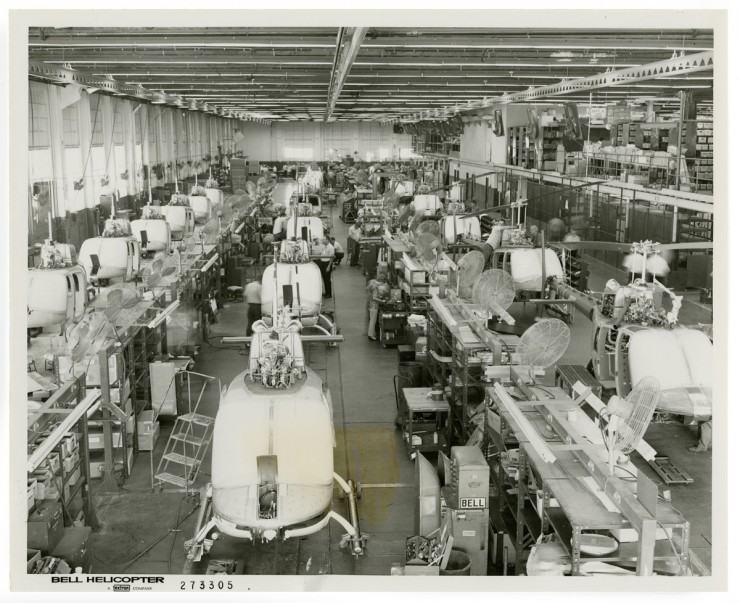
An Assembly Line at Bell Helicopter in Fort Worth from the Lester Strother Texas Metro Magazine Collection, UNT Special Collections.
Everyone everywhere was hit hard by the depression in the 1930s, but some areas were more resilient than others. Fort Worth was one of those cities that enjoyed a profitable comeback, and it was largely due to the area’s burgeoning aviation industry as the country prepared to enter the second world war. Aviation technology remained an important aspect of the Tarrant County economy after the war, and it continues to thrive today.

Jet Research Center Advertisement from the Lester Strother Texas Metro Magazine Collection, UNT Special Collections.
By the end of WWII, Consolidated Vultee Aircraft Corporation (later known as Convair, then General Dynamics) set up camp in Fort Worth and provided jobs to some 35,000 workers. Bell Helicopter arrived in the early 1950s and was also a major employer. Other, smaller corporations, like the Jet Research Center in Arlington brought scientists and researchers to the metroplex, as well.
Carswell Air Force Base (known as Tarrant Field from 1932 to 1948) brought military men from around the country to Fort Worth, where they were trained in the flight of heavy bombing aircraft during the war. The base provided Airmen and equipment during World War II, Vietnam, and the Persian Gulf War. Over 4,000 people were trained at Carswell in the use of B-24 Liberators. These B-24s were produced in a factory adjacent to the base, providing even more economic opportunity. Today, Lockheed Martin owns the Fort Worth Convair factory, as well as the factory adjacent to Carswell.
After the war, Carswell became one of the new Strategic Air Command stations in the country. Strategic Air Command was responsible for a network of military bases, its land-based bomber aircraft, land-based intercontinental ballistic missiles, and all of the atomic weapons owned by the United States. The Command was dismantled in 1992.
Census records show a mushrooming population throughout Tarrant County since the start of WWII, and Carswell Air Force Base, as well as jobs provided by other aviation companies, were a large factor in that boom. Between 1930 and 1950, the population jumped from 197,553 to 361,253. By 1960, 538,495 residents lived in Fort Worth, and that number jumped 67% in 1970 to a whopping 716,317 inhabitants. It is in large part due to this population increase that the southwest metroplex developed many of its infrastructure projects, including highways connecting Fort Worth with Dallas and the mid-cities. Today, these aviation organizations continue to be leading employers in Fort Worth.

General Dynamics Advertisement from the Lester Strother Metro Magazine Collection, UNT Special Collections.
In 1991, Carswell was recommended for closure by the U.S. Department of Defense Base Realignment and Closure Commission, and it was officially closed on September 30, 1993. This news clip from the KXAS-NBC 5 News Collection shows a piece of the inactivation ceremony of the 9th Bomb Squadron in 1992. Today, the base is a Naval Air Station Joint Reserve Base, where commands for the Navy Reserve, National Guard, Air Force, and Marine Corps are located.
The Lester Strother Texas Metro Magazine Records collection offers a variety of information about the aviation industry in Fort Worth, including photographs, correspondence, and articles from Bell Helicopter and General Dynamics. Texas Metro Magazine was founded to support the growing DFW Metroplex and International Airport, and the collection includes 183 linear feet of articles and photographs from the magazine, as well as other grey literature.
-by Alexandra Traxinger Schütz



Leave a Reply